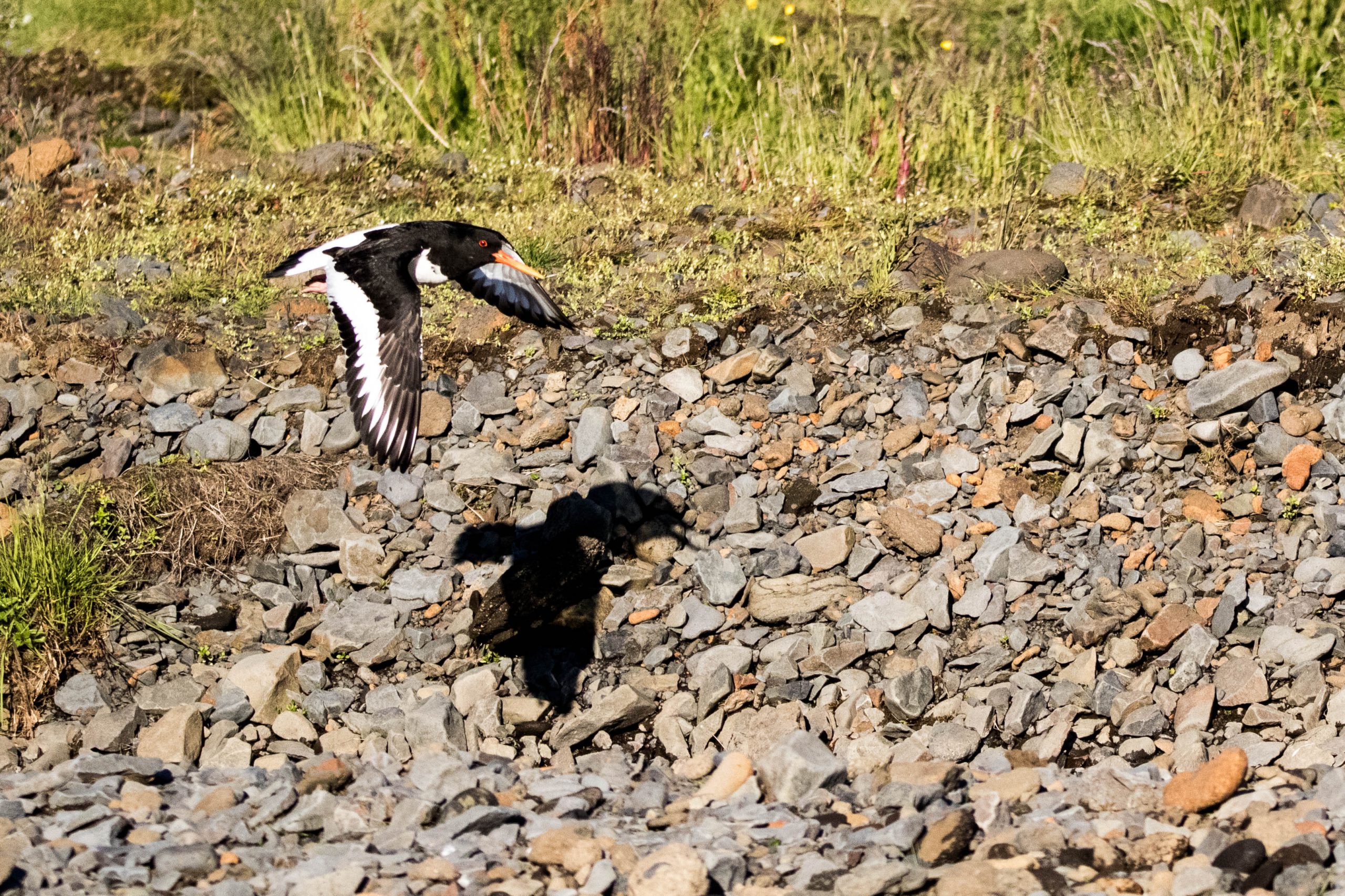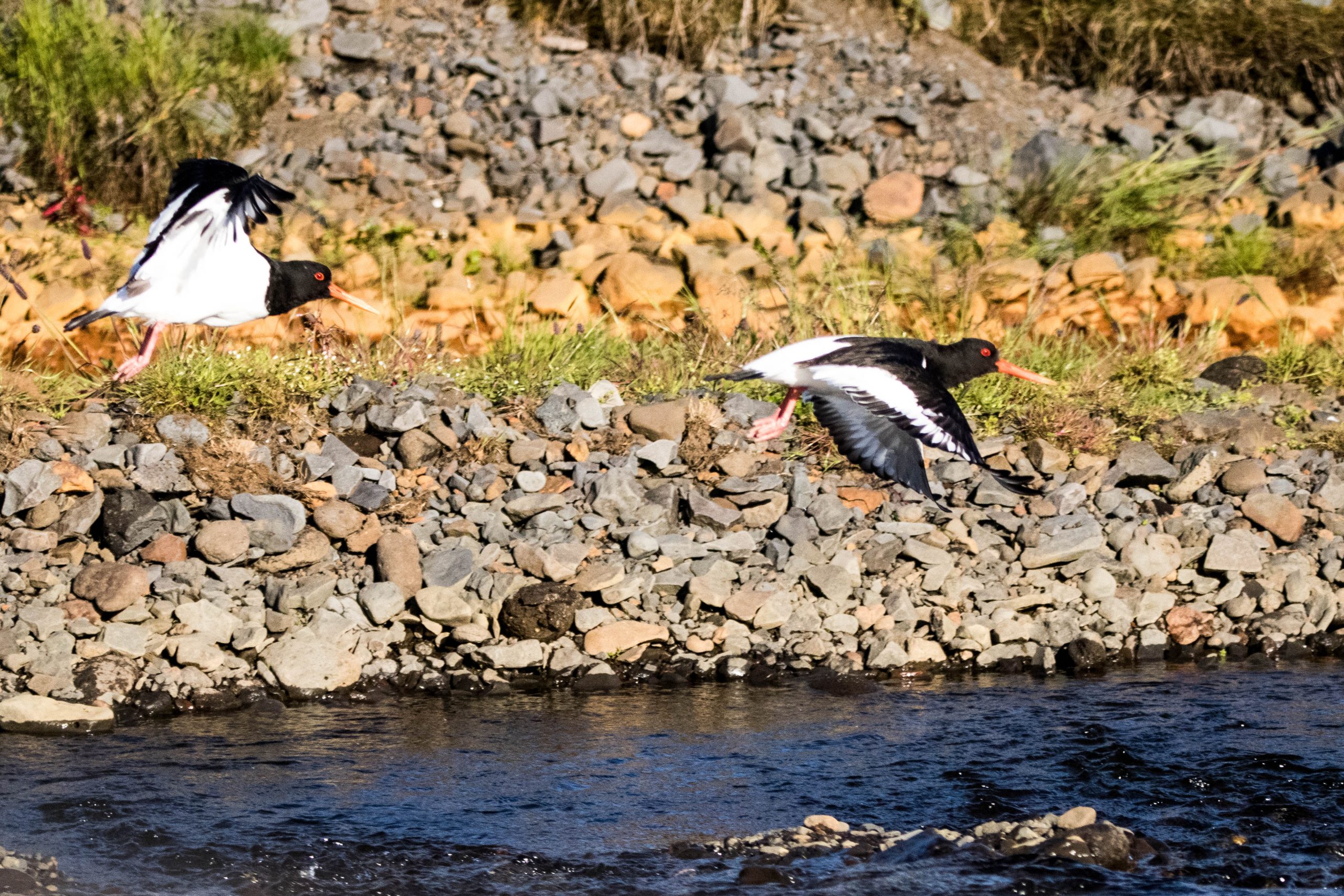All Icelanders know the oystercatcher (Haematopus ostralegus) as it is very noticeable due to its loud calls during summer. The oystercatcher is a wader (Charadrii) belonging to the Haematopodidae family, widely distributed on the coast of western Europe but is also found in East Europe and Asia.
The oystercatcher is black and white and a characteristic for Icelandic shores
The bird is easy to recognize as it is a large wader, weighs about 21 oz, and the length is 15.8-17.7 in. The bird is black, but the wings have a noticeable white strip. Like the belly, sides, and rump are also white. Eyes are bright red with an orange eyering on adults. The feet are long and slender, a feature of waders, dull pink colored. The orange beak is long and straight, 4.1-3.5 in. Juveniles are similar to adults but with more faded color and a dark tip at the beak along with a white throat. The sexes look alike, but the male is slightly larger, The oystercatcher is a fast runner and flyer and a good swimmer.

Distribution and population size
The bird resides all around Iceland but mostly in lowlands and close to shores. His primary nesting habitat is southwest Iceland along the banks of broad rivers and farmed fields. The population is estimated at around 13000 breeding pairs. The oystercatcher is mostly migratory and leaves the country in late fall. However, a big part of the population winters in Great Britain, but some birds migrate to Galicia in northwest Spain. Although, a few thousand birds are stationary on Icelandic shores. Most of them breed in the Breiðafjörður area and are found during the winter in the southwest or southeast Iceland.
The oystercatcher is very loyal to its nesting site
In March, the oystercatcher arrives in Iceland and is seen in large groups feeding on mudflats on the south coast. The courtship starts as soon as the birds come to the country. They are then monogamous and loyal to their companions, often pairing for a lifetime. The birds are also very loyal to their nesting sites, usually nesting at the same spot every year. For instance, a pair has been observed nesting at the same spot for 20 years. The oystercatcher does not nest in colonies, and each pair has its own territory.

The parents feed their young
The nest is a small dent in the ground insulated with straws and gravel most often close to the sea or water. Egglaying starts late April or the beginning of May but can be delayed until June if conditions were adverse the previous months. The eggs are 2-4, brown colored with dark spots. Both sexes incubate the eggs, which hatch in 23-27 days. After hatching, the parents feed the youngs which freely roam the territory. Very few waders feed their youngs, which is a characteristic behavior of the Haematopodidae family.

What do they eat, and how?
Many Oystercatchers are opportunists feeding on the most abundant food in their surroundings. In spring and summer, it is often seen feeding in farm- and wetlands where worms and insects are abundant. At the coast, it feeds on mollusc, both bivalves and gastropods along with polychatea, which it picks up from mudflats with the long beak.
They show different behaviour when feeding on bivalves. Either they use their long beak to cut the bivalves tendon and pull out the fish or they break the bivalve on a stone. The youngs learn the parent’s technique and only use that one.

Did you know?
- The oystercatcher is the national bird of the Faroe Islands.
- The bird is one of few waders that feed their young. Most other wader chicks collect food by themselves after hatching.
- They sometimes nests in cities and towns.
- The average lifespan of an oystercatcher is about 12 years, although the oldest known individual in Iceland was 29 years old but 43 years in England.
- The oystercatcher becomes sexually mature 3-5 years old.
Links for catchers:
Great info from oiseaux-birds.com
More to read from The Royal Society for the Protection of Birds (RSPB)
South Iceland research centre has many wader researches ongoing.
A great blog about oystercatcher and other wader researches.
Icelandic Version – Íslenska
Author: Dr. Þórður Örn Kristjánsson
Photographer: Dr. Þórður Örn Kristjánsson

